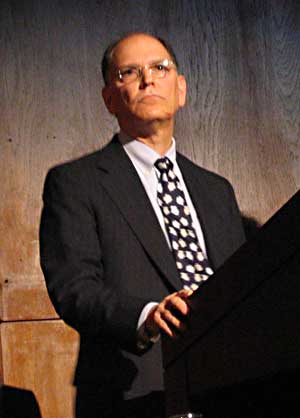

I spent a relaxing afternoon yesterday at the Sackler Museum’s “In the Beginning: Bibles before the Year 1000” exhibit. As I was walking through the gates behind the Smithsonian Castle, I noticed the sign on the fence: WiFi @ SI. Nice! Turns out there are a few free wireless hotspots on the Mall now, this area (Haupt Garden behind the Smithsonian Castle) being one of them.
The exhibit at the Sackler was very interesting- they even have some fragments of the Dead Sea Scrolls (from ~60AD) on display. My favorites were the illuminated manuscripts from the 10th century – especially the purple-stained vellum with real gold/silver lettering. The exhibit goes through Jan 7, so stop by if you get a chance – it’s free.
Professor Jeremy Sabloff gave a talk on Thursday, 11/2/2006 at the Carnegie Institute in Washington, DC.

No, Professor Sabloff is not angry in this picture – he was answering a question and I think the light was in his eyes. This was the only useful picture I came away with; the rest were too blurry since I didn’t want to use a flash.
He spoke for over an hour, explaining areas where “traditional” views of the Maya have changed in the past 20 years or so. Traditional focus has been on the Classic period, from circa 300-800 AD. More recent interest is in the pre- and post-classic periods, and they have been shown to have been much more active than traditional views held.
As one example of more recent views, he cited Tikal – a major Maya center with palaces, temples (pyramids), etc. The earlier view was that such centers were sparsely populated – mostly the domain of the Maya rulers and elite. However current research indicates that Tikal may have had a population as high as 40,000 at its height. Clearly a major urban center, with a large population – not just a place for the elite and ceremonial get-togethers.
Another area of new research is regarding the decline/ collapse of the civilization very quickly after 800 AD. The traditional view was that the major areas were abandoned, and the people dispersed. But more recent views indicate that a major population was maintained in such areas for perhaps many centuries after the Classic period. It is mainly the construction of temples, palaces, and stone monuments that declined.
Prof. Sabloff did contrast his view of the end of the Classic period with Jared Diamond’s view in Collapse. Both agree that environmental issues may well have been the cause of collapse (denuding of forests, over-use of land for agriculture, severe drought, etc.). However, while Diamond contends that the rulers of the time ignored the signs and did nothing, Sabloff commented that they probably actually did too much – and may have made things worse. The belief is that the rulers may have had the people (at the end of the Classic) undergo even more construction of temples, etc. (to appease the gods). This just exacerbated the already bad environmental issues. It’s a toss-up as to which view more closely resembles what our current leaders are doing (regarding the environment).
At the end of the lecture Prof. Sabloff entertained questions from the audience. I got the impression he would have answered more than the 10-15 minutes’ worth but the moderator shut things down. I did manage to go up to him after the lecture and he graciously inscribed two of his books for me [ Cozumel: Late Maya Settlement Patterns and The New Archaeology and the Ancient Maya ]. A number of the illustrations he used during his talk reminded me of illustrations/maps in his book, The New Archaeology.
I recorded the lecture in my iPod. The recording capability of the iPod is ok, but not as good as a “dedicated” recorder. I do use an external microphone, but the lack of record-level settings and a low sampling rate limit the quality of recordings. However I still find it more useful and less distracting than having to take copious notes. Maybe someday I’ll take the time to learn how to cleanup such recordings in say, GarageBand – but for now these are straight off the iPod (well, after conversion to mp3 from the wav format! that the iPod uses for recordings). The first minute or so I was fiddling with the mic; after that it’s fairly steady.
If you ever get a chance to attend one of Prof. Sabloff’s lectures, I highly recommend it.



